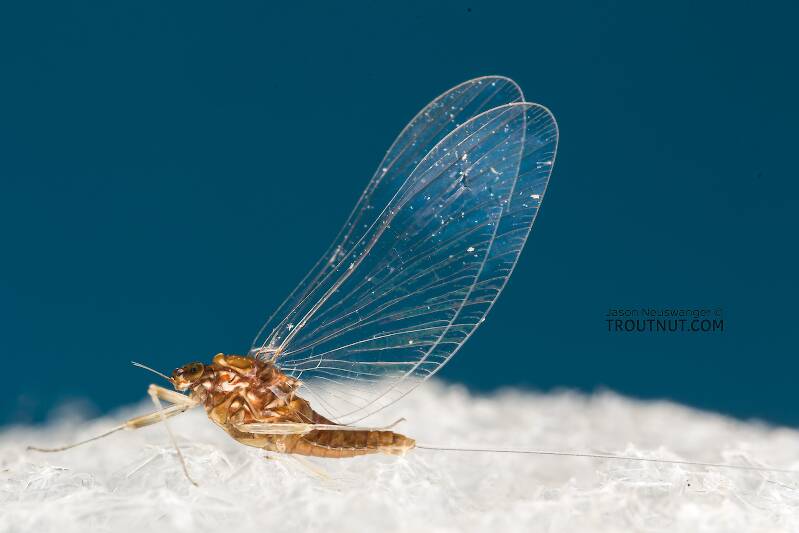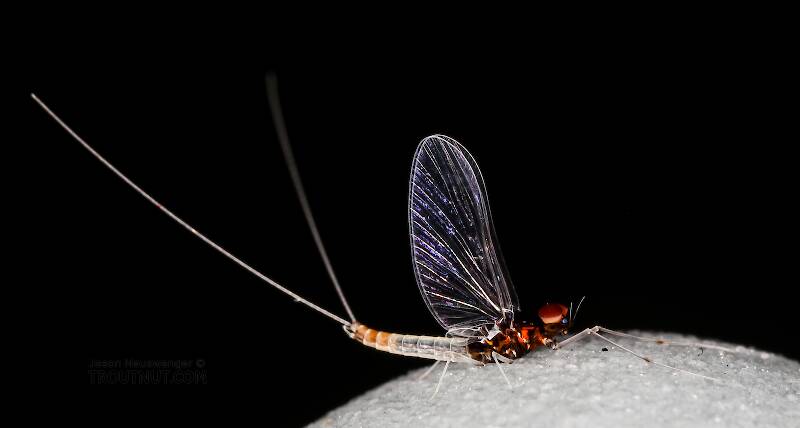
Salmonflies
Pteronarcys californica
The giant Salmonflies of the Western mountains are legendary for their proclivity to elicit consistent dry-fly action and ferocious strikes.
Featured on the forum

This one seems to lead to Couplet 35 of the Key to Genera of Perlodidae Nymphs and the genus Isoperla, but I'm skeptical that's correct based on the general look. I need to get it under the microscope to review several choices in the key, and it'll probably end up a different Perlodidae.

Troutnut is a project started in 2003 by salmonid ecologist Jason "Troutnut" Neuswanger to help anglers and
fly tyers unabashedly embrace the entomological side of the sport. Learn more about Troutnut or
support the project for an enhanced experience here.
Tiny Blue-Winged Olives
Like most common names,"Tiny Blue-Winged Olive" can refer to more than one taxon. They're previewed below, along with 6 specimens. For more detail click through to the scientific names.
Mayfly Genus Acentrella
These are pretty much always called Tiny Blue-Winged Olives.
The only Acentrella species commonly reported to be important to anglers is Acentrella turbida, though Acentrella insignificans is important in some western locales. See the species pages for distribution and timing details. This genus is one of two (including Heterocloeon) that can easily be distinguished from other Baetidae genera by the presence of a conical mesonotal projection. A. turbida lacks hindwings which is useful for distinguishing this species from all others in either genera. A. turbida was previously known by the names of its synonyms Pseudocloeon turbidum in the West and Pseudocloeon carolina in the East.
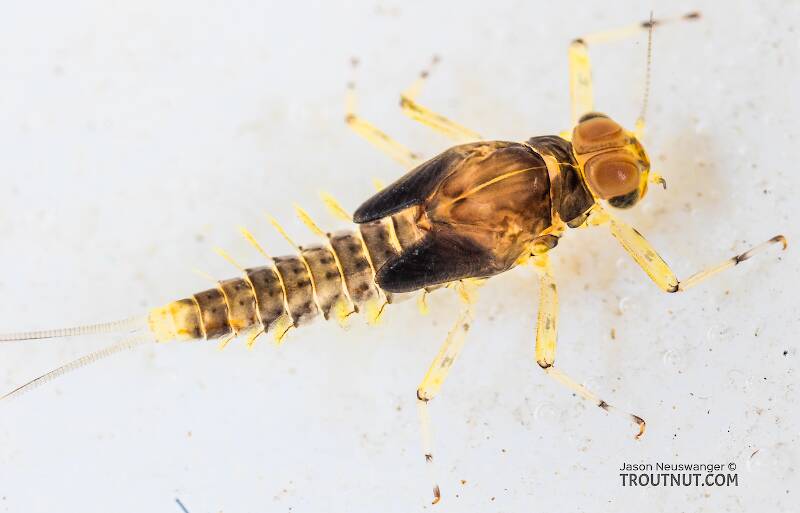
Another nymph probably of the same species as this one emerged and was photographed as a dun and partly-molted spinner.
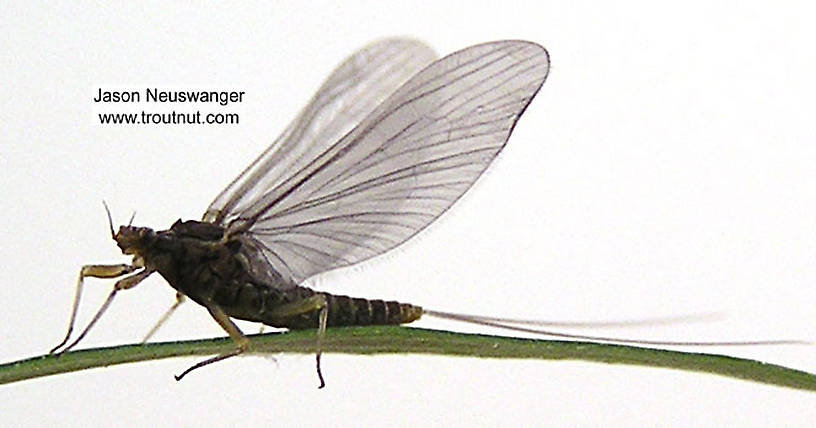
I've lost the date information for this specimen and taken a guess.
See 4 more specimens...
Mayfly Genus Acerpenna
These are pretty much always called Tiny Blue-Winged Olives.
See Acerpenna pygmaea for details. It is the only species known to be of even minor importance to anglers and was previously known as Baetis pygmaeus.
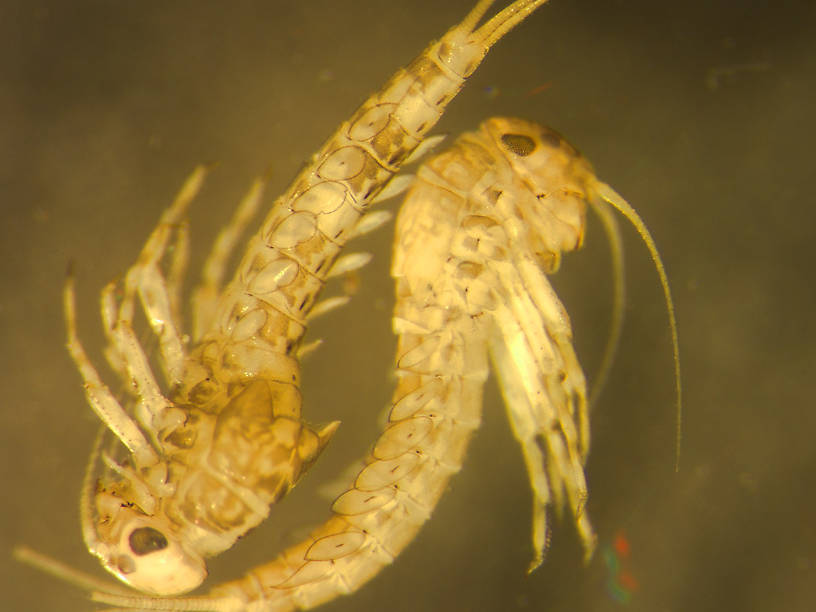
This is a very rare mayfly in western Montana. The shape of the last gill is a key to its identification. I have collected this species in only one location.
See 3 more specimens...
Mayfly Genus Apobaetis
These are pretty much always called Tiny Blue-Winged Olives.
This genus contains only one species of any known significance, Apobaetis futilis, a Western hatch. For anglers looking for correlation with older angler entomologies, this hind wingless little mayfly was formerly known as Pseudocloeon futile.
Mayfly Genus Heterocloeon
These are pretty much always called Tiny Blue-Winged Olives.
Heterocloeon is one of two genera along with Acentrella that can be differentiated from other baetids by the presence of a conical mesonotal projection. All but one species of this genus can be further separated from Acentrella by the lack of venation in the tiny hindwings. There is little evidence that the species of Heterocloeon are of much significance to anglers.
Mayfly Genus Iswaeon
These are pretty much always called Tiny Blue-Winged Olives.
This genus currently contains three species, only one of which is important to anglers. See Iswaeon anoka for details.
Mayfly Genus Labiobaetis
These are pretty much always called Tiny Blue-Winged Olives.
Mayfly Genus Plauditus
These are pretty much always called Tiny Blue-Winged Olives.
Two of the tiny species in this genus may produce fishable hatches: Plauditus dubius in the East and Midwest, and Plauditus punctiventris in the West. The latter is the most prolific and important. Both were previously in the genus Pseudocloeon.
Mayfly Genus Pseudocloeon
These are pretty much always called Tiny Blue-Winged Olives.
Mayfly Species Iswaeon anoka
These are pretty much always called Tiny Blue-Winged Olives.
This tiny hind-wingless Midwestern and Western species can produce excellent hatches because it is so extremely abundant. Its bright green duns are unmistakable. In the West they can also be an equally unmistakable bright almost fluorescent chartreuse, especially as nymphs. They are very common in the Northwest and Rocky Mountain states, with their population densities giving way to the similarly tiny and hind-wingless (though more somber colored) Acentrella species in Southern Oregon, California and the Southwest.
Iswaeon anoka was first brought to the attention of the angling community (as Pseudocloeon anoka) by famous angling author and columnist Joe Brooks. Back in the late 60's he wrote an article for Outdoor Life magazine extolling the work of Doug Swisher and Carl Richards in their forthcoming and groundbreaking book, Selective Trout. This species was featured as the model for their now famous version of the "No-Hackle" dry fly and imitative parachute patterns, sparking a revolution in fly design for hyper-selective trout. The rest as they say, is history...
Iswaeon anoka was first brought to the attention of the angling community (as Pseudocloeon anoka) by famous angling author and columnist Joe Brooks. Back in the late 60's he wrote an article for Outdoor Life magazine extolling the work of Doug Swisher and Carl Richards in their forthcoming and groundbreaking book, Selective Trout. This species was featured as the model for their now famous version of the "No-Hackle" dry fly and imitative parachute patterns, sparking a revolution in fly design for hyper-selective trout. The rest as they say, is history...
Mayfly Species Plauditus dubius
These are pretty much always called Tiny Blue-Winged Olives.
This species may produce good hatches.
Mayfly Species Apobaetis futilis
These are pretty much always called Tiny Blue-Winged Olives.
This hind wingless little mayfly was formerly known as Pseudocloeon futile and can hatch in excellent numbers in certain western locales.
Mayfly Species Acentrella insignificans
These are pretty much always called Tiny Blue-Winged Olives.
This species shares its distribution with the much more common Acentrella turbida over much of it's range. In the West, it overshadows turbida in some locales. It can be differentiated from turbida by the presence of hind wings and from most other baetids by its hind wings having two longitudinal veins and a lack of costal projection. It was previously classified as Baetis insignificans.
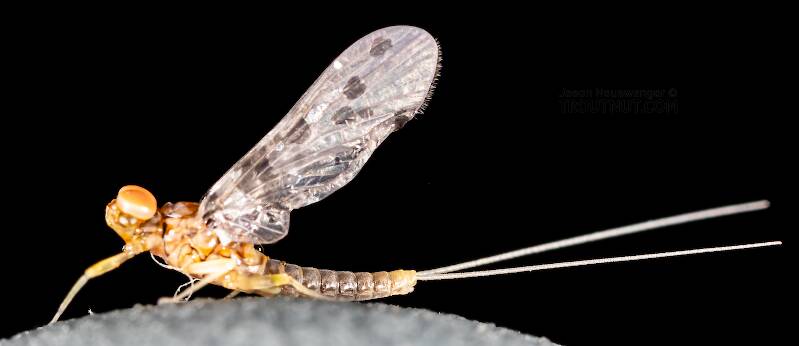
This specimen emerged indoors from nymphs I had collected, then partly molted into a spinner but got stuck along the way. I've included a couple pictures showing some of the spinner colors. It got a bit waterlogged after emerging, so the wings aren't in perfect shape, but it still represents one of two Baetids that were emerging and drawing trout to rise on the Yakima. Based on body size and shape, it is most likely the same species as this nymph.

Another nymph probably of the same species as this one emerged and was photographed as a dun and partly-molted spinner.
Mayfly Species Labiobaetis propinquus
These are pretty much always called Tiny Blue-Winged Olives.
This species was previously known as Baetis propinquus, a name from older nomenclatures and angling literature familiar to many western anglers. Prior to its current listing, it did a brief stint in the genus Pseudocloeon. The irony is that though this species has hind wings, it was the last species remaining in Pseudocloeon (before the genus recent Nearctic taxonomic demise) which was best known for its species lacking hind wings as an identifying character.
Though it has a national distribution its most important hatches occur in the West, usually hatching between the larger broods of Baetis tricaudatus. Western anglers experiencing a hatch can easily confuse them with the larger Baetis bicaudatus as both nymphs appear similar with only two tails. Besides size, the adults can be separated from bicaudatus (with the help of a little magnification) because L. propinquus lacks acute costal projections on its tiny hind wings. Conversely, the presence of hind wings and lack of conical mesonotal projections makes them easy to tell from the more common and equally tiny Acentrella turbida.
Though it has a national distribution its most important hatches occur in the West, usually hatching between the larger broods of Baetis tricaudatus. Western anglers experiencing a hatch can easily confuse them with the larger Baetis bicaudatus as both nymphs appear similar with only two tails. Besides size, the adults can be separated from bicaudatus (with the help of a little magnification) because L. propinquus lacks acute costal projections on its tiny hind wings. Conversely, the presence of hind wings and lack of conical mesonotal projections makes them easy to tell from the more common and equally tiny Acentrella turbida.
Mayfly Species Acerpenna pygmaea
These are pretty much always called Tiny Blue-Winged Olives.
This species is known in older taxonomies under the former name Baetis pygmaeus.
It is a diminutive baetid with distribution across every region. It is reported to have localized hatches of occasional importance.
It is a diminutive baetid with distribution across every region. It is reported to have localized hatches of occasional importance.

This is a very rare mayfly in western Montana. The shape of the last gill is a key to its identification. I have collected this species in only one location.
See 3 more specimens...
Mayfly Species Acentrella turbida
These are pretty much always called Tiny Blue-Winged Olives.
Although these mayflies are tiny, in places their numbers compensate for their small size and make for excellent hatches.
Rick Hafele and Dave Hughes in Western Mayfly Hatches rate turbida as one of the three most "key" western species of Baetidae, alongside Baetis tricaudatus and Diphetor hageni. In the West, turbida is more variable in size and appearance than its eastern iteration, in keeping with the large and varied regions it inhabits. It can run as small as 3.5 mm and as large as 5 mm, the larger sizes tending to be more brownish. It is often confused with the smaller broods of Diphetor hageni, but its conical mesonotal projection, lack of hind-wings, exaggerated turbinate eyes (hence its name) and stockier build help to differentiate it.
They are often found on the water with a mix of other Baetidae mayflies, making for very challenging fishing.
Rick Hafele and Dave Hughes in Western Mayfly Hatches rate turbida as one of the three most "key" western species of Baetidae, alongside Baetis tricaudatus and Diphetor hageni. In the West, turbida is more variable in size and appearance than its eastern iteration, in keeping with the large and varied regions it inhabits. It can run as small as 3.5 mm and as large as 5 mm, the larger sizes tending to be more brownish. It is often confused with the smaller broods of Diphetor hageni, but its conical mesonotal projection, lack of hind-wings, exaggerated turbinate eyes (hence its name) and stockier build help to differentiate it.
They are often found on the water with a mix of other Baetidae mayflies, making for very challenging fishing.
See 3 more specimens...
Mayfly Species Baetis intercalaris
These are often called Tiny Blue-Winged Olives.
Mayfly Species Plauditus punctiventris
These are very rarely called Tiny Blue-Winged Olives.
This species produces very strong hatches on fertile Western spring creeks. They are extremely small mayflies but may be extremely numerous.
References
- Hafele, Rick and Hughes, Dave. 2004. Western Mayfly Hatches. Frank Amato Publications.


